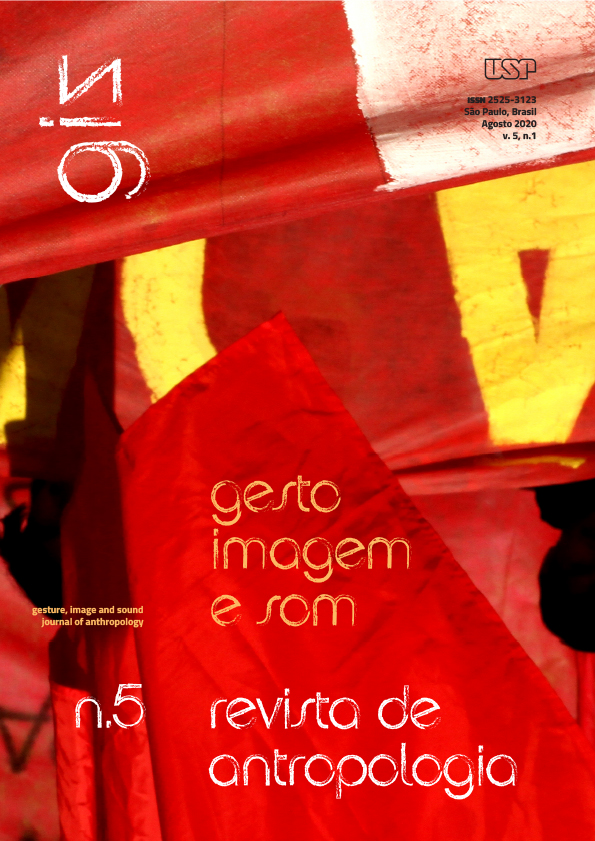Films as things in colonial India
DOI:
https://doi.org/10.11606/issn.2525-3123.gis.2020.171664Keywords:
Visual anthropology;, India;, Colonial filmAbstract
This paper argues that the visual is also material, in the sense that visual objects (even digital ones) can circulate through a variety of different spaces and, depending on the context, may acquire or express very different properties. This paper draws upon research conducted by the author in film archives in both India and the UK, aiming to show that non-fiction films (and lengths of film footage) shot by British colonial officials and visitors to India in the first half of the 20th century form visual “documents” that draw upon earlier film and photographic conventions.Concurrently, the nascent Indian fiction film gets underway, with the pioneering work of D. G. Phalke. Both cinemas use the same materials – even possibly the same kinds of camera – yet never intersect. The films of this period, and subsequently,have to be considered so one can understand visual relations between Indian subjects and British colonisers.
Downloads
References
Banks, Marcus and David Zeitlyn. 2015. Visual methods in social research. London: Sage.
Bayly, Christopher A. 1986. The origins of swadeshi (home industry): cloth and Indian society: 1700-1930. In The social life of things: commodities in cultural perspective, ed. Arjun Appadurai, 285-322. Cambridge: Cambridge University Press.
Benjamin, Walter. 1992. The work of art in the age of mechanical reproduction. In Illuminations, ed. Hannah Arendt, 211-244. London: Fontana.
Chabria, Suresh. 1994. Before our eyes: a short history of India’s silent cinema. In Light of Asia: Indian silent cinema 1912-1934, eds. Suresh Chabria and Paolo Cherchi Usai, 3-24. New Delhi: Wiley Eastern.
Chabria, Suresh and Paolo Cherchi Usai, eds. 1994. Light of Asia: Indian silent cinema 1912-1934. New Delhi: Wiley Eastern.
Edwards, Elizabeth. 2001. Raw histories: photographs, anthropology and museums. Oxford: Berg.
Gutman, Judith. 1982. Through Indian eyes: 19th and early 20th century photography from India. New York: Oxford University Press.
Hamilton, Peter and Roger Hargreaves. 2001. The beautiful and the dammed: nineteenth-century portrait photography. London: National Portrait Gallery.
Kopytoff, Igor. 1986. The cultural biography of things: commoditization as process. In The social life of things: commodities in cultural perspective, ed. Arjun Appadurai, 64-92. Cambridge: Cambridge University Press.
Mirzoeff, Nicholas. 1999. An introduction to visual culture. London: Routledge.
Morphy, Howard and Marcus Banks. 1997. Introduction: rethinking visual anthropology. In Rethinking visual anthropology, eds. Marcus Banks and Howard Morphy, 1-35. London, New Haven: Yale University Press.
Phillips, Sandra S., Mark Haworth-Booth and Carol Squiers. 1997. Police pictures: the photograph as evidence. San Francisco: San Francisco Museum of Modern Art, Chronicle Books.
Pinney, Christopher. 1992. Montage, doubling and the mouth of god. In Ethnographic film aesthetics and narrative traditions: proceedings from NAFA 2, eds. Peter Ian Crawford and Jan K. Simonsen, 77-106. Aarhus: Intervention Press.
Pinney, Christopher. 1997. Camera Indica: the social life of Indian photographs. London: Reaktion Books.
Rajadhyaksha, Ashish. 1994. India’s silent cinema: “a viewer’s view”. In Light of Asia: Indian silent cinema 1912-1934, eds. Suresh Chabria and Paolo Cherchi Usai, 25-40. New Delhi: Wiley Eastern.
Rajadhyaksha, Ashish and Paul Willemen. 1994. Encyclopaedia of Indian cinema. London, New Delhi: British Film Institute, Oxford University Press.
Ruby, Jay. 2000. Picturing culture: explorations in film and anthropology. Chicago: University of Chicago Press.
Tarlo, Emma. 1996. Clothing matters: dress and identity in India. London: Hurst and Company.
Taylor, Lucien. 1998. “Visual anthropology is dead, long live visual anthropology”. American Anthropologist, vol. 100, no. 2: 534-537.
Thomas, Nicholas. 1991. Entangled objects: exchange, material culture, and colonialism in the Pacific. Cambridge, MA, London: Harvard University Press.
Vaughan, Megan. 1991. Curing their ills: colonial power illness. Stanford: Stanford University Press.
Downloads
Published
Issue
Section
License
Authors who publish in this journal agree to the following terms:
a. All rights reserved for authors. Journal has right to first publication. Work is simultaneously licensed under Creative Commons Attribution License which permits sharing work with recognition of authorship and initial publication in this journal for non-commercial ends.
b. Authors are authorized to separately make additional contracts for non-exclusive distribution of version of work published in this journal (e. g. publish in institutional repository or as book chapter), with recognition of authorship and initial publication in this journal.







